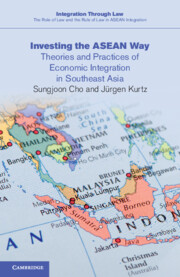Book contents
- Investing the ASEAN Way
- Integration Through Law
- Investing the ASEAN Way
- Copyright page
- Contents
- Figures
- Tables
- Preface
- General Editors’ Preface
- Acknowledgments
- Table of Cases
- Abbreviations
- Chapter 1 Introduction
- Chapter 2 The Foundation of the ASEAN Investment Regime
- Chapter 3 Tracing Influences on the ASEAN Investment Regime
- Chapter 4 Positioning of the ASEAN Investment Regime
- Chapter 5 Synthesis
- Chapter 6 Conclusion: Economic Regionalism and ASEAN Investment
- Bibliography
- Index
Chapter 4 - Positioning of the ASEAN Investment Regime
Published online by Cambridge University Press: 10 November 2022
- Investing the ASEAN Way
- Integration Through Law
- Investing the ASEAN Way
- Copyright page
- Contents
- Figures
- Tables
- Preface
- General Editors’ Preface
- Acknowledgments
- Table of Cases
- Abbreviations
- Chapter 1 Introduction
- Chapter 2 The Foundation of the ASEAN Investment Regime
- Chapter 3 Tracing Influences on the ASEAN Investment Regime
- Chapter 4 Positioning of the ASEAN Investment Regime
- Chapter 5 Synthesis
- Chapter 6 Conclusion: Economic Regionalism and ASEAN Investment
- Bibliography
- Index
Summary
Chapter 4 builds upon the legalization assessment by focusing on the latest (and current) iteration of the AIR: the 2009 ASEAN Comprehensive Investment Agreement (ACIA). What is distinct about the ASEAN investment project – and potentially transformative – is the evolution in objectives surrounding the role of treaty disciplines. By the time of the ACIA, those treaty constraints would no longer be used as part of a simple BIT-style project of delivering investment protection with the hope that this would somehow translate into greater flows of foreign investment. Instead, the ASEAN members now seek to strategically position their region as an integrated production base for foreign investment, thereby leveraging one of the fastest and most dynamic aspects of the global economy. Yet, clearly, the AIR continues to exhibit a low degree of legalization measured against conventional benchmark indicators. Chapter 4 seeks to contextualize and explain this low degree of legalization through both the ASEAN Way and negative social learning. The adaptation and reimagination embedded into the AIR calls into question universalist assumptions underpinning the concept of legalization and highlights the idiographic nature of legalization from a comparative law perspective. We argue instead that delegalization can be an independent and entirely legitimate mode of legalization.
Keywords
- Type
- Chapter
- Information
- Investing the ASEAN WayTheories and Practices of Economic Integration in Southeast Asia, pp. 116 - 156Publisher: Cambridge University PressPrint publication year: 2022



